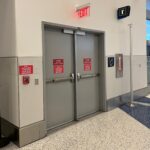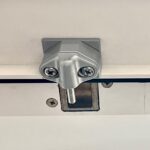 Quite a few questions came up during my webinar on touchless door openings, and here’s one of them:
Quite a few questions came up during my webinar on touchless door openings, and here’s one of them:
Do the requirements of NFPA 80 “trump” the ADA requirements? Is fire protection more important than accessibility?
The short answer: No.
Here’s the long(er) answer…
The ADA is a federal civil rights law and it applies nationwide – the ADA Standards for Accessible Design establish the criteria for accessible buildings. ICC A117.1 is the accessibility standard referenced by the International Building Code (IBC) and other model codes. These two publications are very similar, but states or local jurisdictions may also have their own accessibility requirements. It’s important to be aware of all of the applicable standards.
Thirty years ago, buildings typically had designated accessible routes, and the doors on those routes were required to comply with the accessibility standards; that philosophy has changed. There’s a lot of great background information on this in the IBC Commentary. Here’s an excerpt:
The fundamental philosophy of the code on the subject of accessibility is that everything is required to be accessible. This is reflected in the basic applicability requirement (see Section 1103.1). The code’s scoping requirements then address the conditions under which accessibility is not required in terms of exceptions to this general mandate. In the early 1990s, building codes tended to describe where accessibility was required in each occupancy, and any circumstance not specifically identified was excluded. The more recent codes represent a fundamental change in approach. Now one must think of accessibility in terms of “if it is not specifically exempted, it must be accessible.”
There are some locations that are exempt from the accessibility requirements, but they are very limited. For example, employee work areas are exempt, BUT – the entrances and exits to those areas must comply, AND – corridors, toilet rooms, kitchenettes, and break rooms are not considered employee work areas. There is more information about the exempted areas in this post, and employee work areas are covered here.
Back to fire doors…
Fire doors are not exempt from the accessibility standards. However, there is at least one compromise that I can think of. The ADA Standards and ICC A117.1 require interior doors to be opened with no more than 5 pounds of opening force. Fire doors and exterior doors are not required to comply with this limitation, because they may not close and latch properly given the amount of closing force generated by a closer that opens with 5 pounds of force. Although exempt from the opening force requirement, fire doors (and exterior doors) would still have to comply with other accessibility requirements, like closing speed, clear opening width, and hardware operation.
Fire doors and exterior doors are not allowed to have unlimited opening force – the maximum opening force for these doors is addressed by the IBC. Fire doors and exterior doors must not require more than 15 pounds to release the latch, 30 pounds to set the door in motion, and 15 pounds to open the door to the fully-open position. There are additional egress requirements that also apply to the vast majority of doors.
The bottom line is that most fire doors have to comply with requirements for egress, fire protection, and accessibility, and there may be multiple codes and standards that apply to a particular project. All of those requirements must be considered in order to ensure that the door in question will provide free egress, be operable by all building occupants, and if it’s a fire door – help to compartmentalize the building and protect the means of egress.
The recordings of all of my webinars, with the written Q&A and other resources, are available on the Webinars page of iDigHardware.
You need to login or register to bookmark/favorite this content.






While I’ve never had an issue with an AHJ, I’ve always wondered about the door-force question. I generally call them Schrodinger’s Doors, as they must open and remain closed at 5 pounds (22.2 N) of force. One other door situation not specifically addressed is powered doors in hospital (non-rated) corridors without latches. NFPA 101 (18.3.6.3.7(2)) allows powered doors to be exempt from latching in hospital corridors as long as they remain closed at 5 lbs of force, with or without power. Since ADA requires it to open at 5 lbs of force, it must both begin opening and remain closed at that force. But it’s only a semantic argument, as at 5.00001 lbs the door opens, and at 4.99999 lbs the door remains closed. I try not to split hairs, but I always have a moment of pause when an Owner wants this situation (it’s rare).
Unless you are in California, where the State Architect (DSA), has decided to ignore the Code, A117.1-2017, Access-Board.Gov and other definitive sources, and rule that 5lbs applies to all doors regardless of use, rating, or location. This is a dangerous interpretation that has lasted for the past few years and still not addressed in 2019 code adoption cycle.
Not only is this interpretation potentially dangerous, it makes HVAC systems ineffective and makes balancing doors nearly impossible. This interpretation causes far more harm than any potential good that may have inspired it.
You make a good point, Nathan.
– Lori
In Ohio, the Ohio Building Code does not include the complete NFPA 80 document. They do take parts of NFPA 80 and incorporate them into their code. The OBC should be review first.
So to be clear, a fire rated door does not need to comply with the opening force required for ADA? I don’t understand why they could be the same. I don’t think the difference in 5lbs verses 15lbs for opening would make that much difference.
Hi Donnie –
The 5-pound requirement in the ADA and A117.1 does not apply to fire doors or exterior doors. If there isn’t a state or local requirement, the IBC requirement is 15 pounds to release the latch, 30 pounds to set the door in motion, and 15 pounds to open the door to the fully-open position.
– Lori